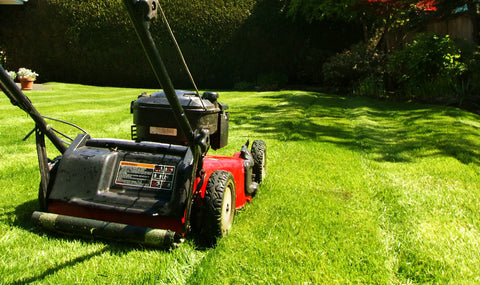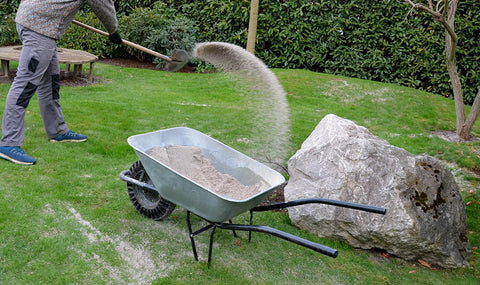When creating or maintaining your turf, a level lawn with a surface slope for surface water runoff is the desired goal. Eliminating surface depressions and holes within your lawn is a continuous process. Adding sand or topsoil without removing turfgrass is a cultural practice used by professional turf managers to provide athletes with a safe surface to play. Also, golf course superintendents add sand to putting greens for leveling, ball roll, and thatch management. While correcting the surface grade by adding material, important biological activity is taking place that increases the health of your lawn.
Identifying Areas To Be Corrected
Determining specific areas requiring elevation and grade correction can be easily identified by simply strolling across your emerald green and lush lawn. Not only can one see visually, but one can also feel under the feet if the surface is smooth or inconsistent in the overall grade. Usually, the feeling of walking across the lawn is more defining than the actual grade. Small areas may exist that cannot be visually apparent. Mowing your lawn is another way to feel the grade.


First, drive a surveying stake into your lawn at any given point. Tie the string line 6” upon the stake. Second, drive another stake at a higher or lower elevation and repeat the process. Once the string is very tight, place the string line bubble level on the string line and adjust the height of the stakes until the string line is perfectly level.
Utilizing your tape measure, you can measure the distance from the string down to the surface of your lawn every ten linear feet. The different measurements will indicate if the surface is consistent in slope or requires corrective action.
What Is Topdressing?
Topdressing is adding sand or soil material over turfgrass while serving different purposes. Not only does this adjust the grade and fill low areas, but it is also responsible for injecting beneficial microorganisms into your lawn that play a significant role in managing thatch. Topdressing is normally performed on something other than home lawns, but it is something that every lawn needs.
As turfgrass ages, it builds thatch and organic material. Thatch can become a severe issue unless core aeration, dethatching, and topdressing occur repeatedly. Although performing this task on large turf areas can be expensive, smaller lawns are top-dressed for a reasonable price.

Purchasing the correct topdressing material is the most critical step taken. Sands, topsoils, or engineered soils must meet a particular specification to create a better grass-growing environment. Processed sand and screened topdressing materials must be utilized to avoid drainage and other soil issues. Not all are the same when purchasing bagged material at one of your favorite garden centers. Materials that have been screened and are consistent in texture are ideal when searching for topsoil and sand for topdressing to correct grade issues. Installing materials that have large particle debris, excess moisture, and possible weed seeds will only cause additional problems in the future.
Topdressing for Warm Season and Cool Season Lawns
Improving the grade of your lawn or turfgrass areas depends on the type of turfgrass that is present. You need to apply the right amount at the correct depth. Covering the plant totally with topdressing material could result in delayed growth. It is always best to wait until the grass is actively growing before applying fill to the grade of your lawn. Initially, it will appear that the topdressing depth is too thick, but when grooming the material, it will work down into the thatch layer below the crown of the plant.
However, it could be too dense if the leaf blades are not visible after working the soil. Warm-season turfgrasses such as Bermuda, Zoysia, Seashore Paspalum, Bahia, St. Augustine, and others will rapidly grow. Cool season turfgrasses should only be topdressed when the turf is actively growing and not during stressful times. Sands are abrasive and will be visible in the leaf tissue after dragging in the sand. Irrigating after the topdressing process will also aid in settling the material.
Watering also assists in the recovery of the abrasive appearance on the leaf blades and tissue. Core aeration typically precedes topdressing activity. The applied topdressing material theoretically fills the holes to increase oxygen within the root zone, reduces thatch through microbial activity, and produces a consistent grade on your lawn. The results will be easily seen over time as the practice continues each season.
The Process
First, evaluate the overall grade of your lawn. Mark areas that are low and high. Utilizing a laser level is excellent and accurate but impractical for most homeowners. Therefore, the string method described above is a great tool to see the difference in grade from one point to another. Select quality topsoil or topdressing sand that doesn’t contain fine sand and silt particles, as this will alter the internal drainage and increase surface moisture. Smooth the surface after the material has been applied to the level.

Remember, you want to be able to visually see the leaf tissue through the topdressing material to ensure the plant will receive UV rays, allow the plant to produce chlorophyll, and allow the turfgrass biological process to take place. It is irrigating after the material has been leveled and assists in working the material downward into the thatch layer or core openings from aeration. Never exceed ½” in thickness in a single application. Allow time for the process to be completed and repeated throughout the life of your lawn. The benefits will be apparent in time, and a significant difference will occur in turfgrass maintenance.









